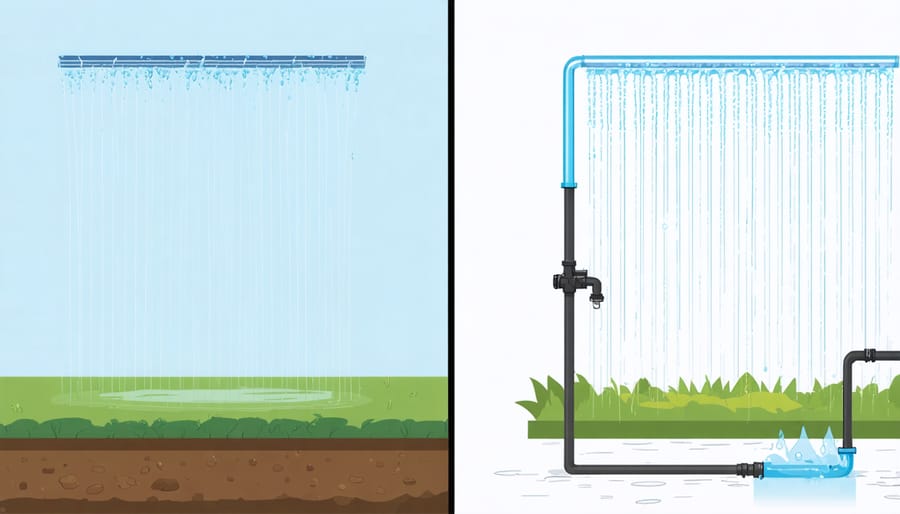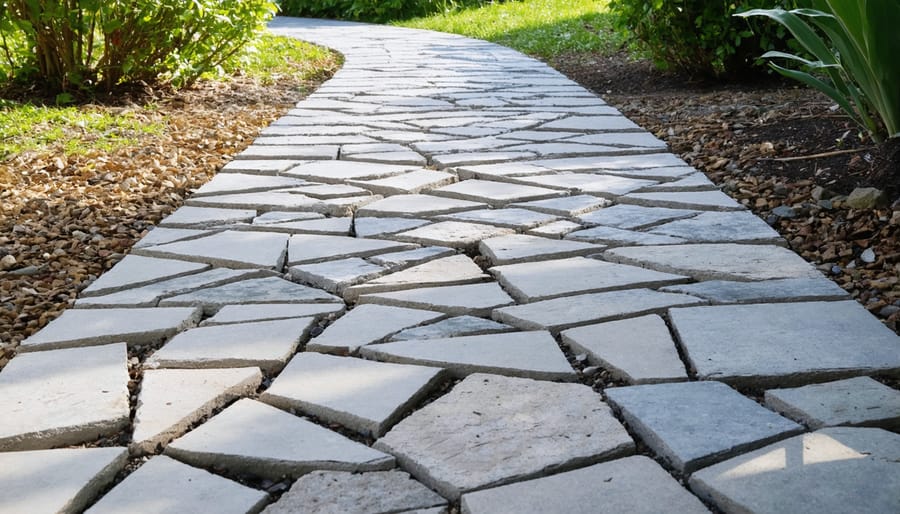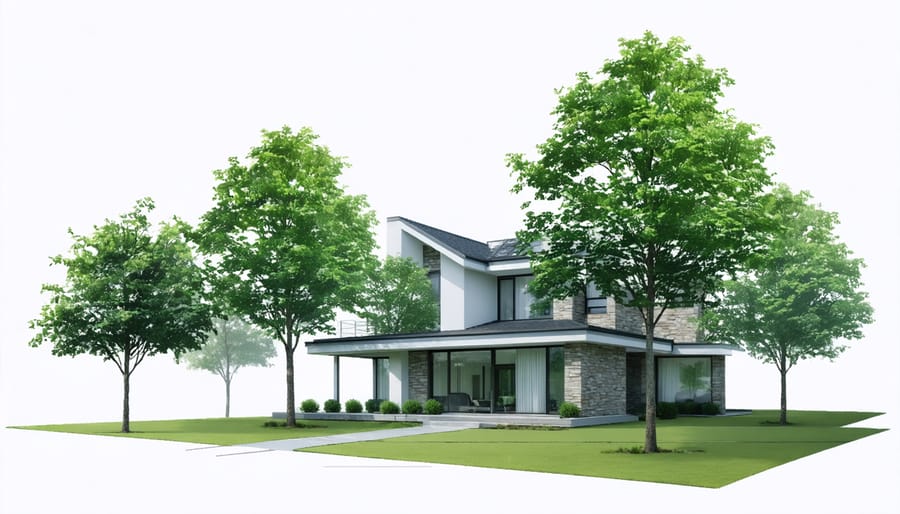Transform your outdoor space into a thriving eco-system by replacing traditional grass with native groundcovers, installing a smart drip irrigation system, and creating natural wildlife habitats with indigenous plants. Implement budget-friendly landscaping solutions like rainwater harvesting systems and permeable paving materials to minimize environmental impact while maximizing your garden’s natural beauty. Design your landscape with strategically placed trees for natural cooling, incorporate composting stations to reduce waste, and select drought-resistant plants that thrive in your local climate. These sustainable choices not only create a stunning outdoor sanctuary but also support local biodiversity, reduce water consumption, and lower maintenance costs – all while contributing to a healthier planet. Whether you’re redesigning your entire yard or making gradual improvements, each eco-friendly choice brings you closer to a sustainable, beautiful outdoor space that works in harmony with nature.

Smart Water Management Solutions
Rainwater Harvesting Systems
Harnessing rainwater is one of the smartest ways to maintain a beautiful landscape while reducing your water bill and environmental impact. A basic rainwater harvesting system can collect thousands of gallons of free water annually – perfect for keeping your garden thriving during dry spells.
The simplest way to start is by installing rain barrels under your downspouts. These 50-100 gallon containers can quickly fill up during a good rain shower, providing you with chemical-free water for your plants. For those ready to take it further, consider installing a larger underground cistern system, which can store several hundred gallons for extended use.
To maximize your rainwater collection, install gutters and downspouts strategically around your home. Add debris filters to keep leaves and twigs from clogging the system, and consider a first-flush diverter to ensure the cleanest water possible makes it into your storage.
Make the most of your harvested rainwater by connecting it to a drip irrigation system or soaker hoses. This ensures water is delivered directly to plant roots with minimal waste. You can also use gravity-fed systems by elevating your rain barrels on sturdy platforms, eliminating the need for pumps.
Remember to check local regulations before installing a large-scale system, as some areas have specific requirements for rainwater collection. Start small with one or two rain barrels and expand your system as you become more comfortable with rainwater harvesting.
Drought-Resistant Plant Selection
Creating a drought-resistant garden doesn’t mean sacrificing beauty for practicality. By choosing the right plants, you can maintain a stunning landscape while significantly reducing your water usage. Start by considering native plants that naturally thrive in your region’s climate – they’re already adapted to local rainfall patterns and soil conditions.
Succulents are excellent choices for water-wise gardens, offering fascinating shapes and colors. Popular options include agave, sedum, and echeveria, which store water in their thick leaves. For flowering beauty, consider drought-tolerant perennials like lavender, salvia, and black-eyed susans, which provide gorgeous blooms with minimal watering needs.
Ornamental grasses like fountain grass and blue fescue add movement and texture to your landscape while requiring very little maintenance. Mediterranean herbs such as rosemary, sage, and thyme not only conserve water but also offer practical value for cooking.
When planning your drought-resistant garden, group plants with similar water needs together. This practice, known as hydrozoning, ensures efficient water use and prevents overwatering. Consider the mature size of plants and their sun exposure requirements to create a well-balanced landscape.
Pro tip: Add a 2-3 inch layer of mulch around your drought-resistant plants to retain soil moisture and reduce evaporation. This simple step can cut your water needs by up to 50% while keeping roots cool and healthy.
Sustainable Materials for Hardscaping
Recycled and Reclaimed Materials
Transform your landscape into an eco-friendly paradise by incorporating recycled and reclaimed materials that add character while reducing waste. Old wooden pallets can be reimagined as vertical gardens, perfect for growing herbs or creating living walls. Broken concrete pieces, often called “urbanite,” make excellent retaining walls or stepping stones, adding a rustic charm to your garden paths.
Give new life to glass bottles by embedding them in garden walls for a stunning stained-glass effect, or use them as creative garden bed borders. Salvaged brick and stone from demolition sites can create beautiful pathways, while reclaimed timber makes perfect raised beds and garden benches.
Metal items find new purpose too – old wheelbarrows become unique planters, while retired bicycles transform into whimsical garden art. Consider using recycled plastic lumber for decking and fencing – it’s durable, maintenance-free, and keeps plastic out of landfills.
Local salvage yards and construction sites are treasure troves for materials. Before starting your project, clean and inspect all recycled items thoroughly. For safety, avoid materials that might have been treated with harmful chemicals or contain sharp edges.
Creative tip: Transform old windows into cold frames for starting seedlings, and repurpose ceramic tiles into colorful mosaic features. Remember, when using recycled materials, proper preparation and installation are key to ensuring your eco-friendly additions are both beautiful and lasting.

Permeable Paving Options
Transform your driveway and walkways into eco-friendly features with permeable paving options that allow rainwater to naturally filter into the ground. These sustainable alternatives not only reduce runoff but also help replenish groundwater supplies and prevent flooding.
Gravel is perhaps the most straightforward and budget-friendly option. It’s perfect for driveways and garden paths, offering excellent drainage while creating a charming, rustic look. For a more structured appearance, consider permeable pavers – interlocking blocks with spaces between them that allow water to seep through. These come in various styles and colors to match your home’s aesthetic.
Grass pavers are another fantastic choice, combining the durability of traditional paving with the beauty of a lawn. These hollow grid systems protect grass roots while supporting vehicle weight, creating a seamless blend between your driveway and landscape. For areas with lighter traffic, consider porous concrete or asphalt. These materials look similar to their traditional counterparts but contain tiny holes that allow water to pass through.
For garden paths, stepping stones set in gravel or ground cover plants offer an attractive, permeable solution. You can get creative with patterns and materials, using recycled concrete pieces or natural stone to create unique designs. Remember to prepare a proper base layer with crushed stone for adequate drainage, and consider your local climate when selecting materials – some options may work better in certain weather conditions than others.
Natural Pest Control and Maintenance
Companion Planting Strategies
Companion planting is a smart, natural way to keep your garden thriving while deterring unwanted pests. By strategically placing certain plants together, you can create a harmonious ecosystem that protects and nurtures your landscape naturally.
Start by planting marigolds throughout your garden beds – these cheerful flowers are natural pest deterrents and look beautiful while protecting your other plants from harmful insects. Pair tomatoes with basil, as this classic combination not only improves flavor but also repels flies and mosquitoes. Plant lavender near your roses to deter aphids while adding a lovely purple accent to your landscape.
For vegetable gardens, try the “Three Sisters” method: corn, beans, and squash planted together. The corn provides support for the climbing beans, while the squash spreads along the ground, providing natural weed control and moisture retention. Plant nasturtiums as border flowers – they act as a sacrifice plant, attracting aphids away from your prized vegetables.
Consider aromatic herbs like rosemary, thyme, and mint as natural pest controllers. Just remember to plant mint in containers, as it can spread aggressively. Integrate native flowers like echinacea and yarrow, which attract beneficial insects that prey on garden pests while supporting local pollinators.
These natural partnerships create a beautiful, productive landscape while reducing the need for chemical pesticides – a win-win for both your garden and the environment.
Organic Soil Management
Healthy soil is the foundation of any thriving eco-friendly landscape, and you don’t need synthetic fertilizers to achieve it. Start by getting to know your soil through a simple home testing kit – this will help you understand what nutrients your garden needs naturally.
Composting is your best friend when it comes to organic soil management. Create your own nutrient-rich compost by mixing kitchen scraps, yard waste, and fallen leaves. Layer these materials with a balance of “greens” (nitrogen-rich materials like grass clippings) and “browns” (carbon-rich materials like dried leaves) for optimal results.
Consider adding beneficial organisms to your soil ecosystem. Earthworms are natural tillers that improve soil structure and nutrient availability. You can encourage their presence by maintaining moisture levels and adding organic matter regularly.
Cover cropping is another excellent strategy – plant clover or other nitrogen-fixing plants during off-seasons to naturally enrich your soil. When it’s time to plant, simply turn these crops back into the soil as green manure.
Mulching with organic materials like straw, wood chips, or leaves helps retain moisture, suppress weeds, and gradually break down to feed your soil. Apply a 2-3 inch layer around plants, keeping it away from stems to prevent rot.
Remember to avoid excessive tilling, as it disrupts beneficial soil organisms and natural soil structure. Instead, practice minimal soil disturbance and let nature’s processes work their magic.
Wildlife-Friendly Features
Native Plant Gardens
Native plant gardens are a game-changer for eco-friendly landscaping, offering a perfect blend of beauty and environmental consciousness. By choosing native plants for your landscape, you’re creating a sanctuary that naturally thrives in your local climate while supporting local wildlife and reducing maintenance needs.
These plants have evolved to flourish in your region’s specific conditions, meaning they require less water, fertilizer, and overall care than non-native species. They’re already adapted to local rainfall patterns and soil types, making them incredibly resilient and self-sufficient. Plus, they provide essential habitat and food sources for local birds, butterflies, and beneficial insects.
Creating a native plant garden is surprisingly straightforward. Start by researching plants indigenous to your area and consider their growing requirements, such as sunlight and soil preferences. Group plants with similar needs together to create visually appealing clusters while maintaining efficient water usage. Consider incorporating different heights and textures to create visual interest throughout the seasons.
The benefits extend beyond environmental impact. Native gardens can significantly reduce your maintenance time and costs, eliminate the need for chemical fertilizers and pesticides, and create a unique landscape that stands out from cookie-cutter yard designs. As an added bonus, you’ll enjoy watching your garden become a hub of local wildlife activity, bringing nature right to your doorstep.

Natural Habitat Elements
Creating a wildlife-friendly landscape isn’t just good for the environment – it brings your garden to life with the sights and sounds of nature. Start by incorporating native plants that provide food and shelter for local birds, butterflies, and beneficial insects. Berry-producing shrubs, flowering perennials, and seed-bearing plants are excellent choices that offer natural food sources throughout the seasons.
Water features like small ponds or bird baths serve as vital drinking and bathing spots for wildlife. Consider installing a shallow water feature with gradually sloping sides to make it accessible for various creatures. Adding a few partially submerged rocks creates safe landing spots for butterflies and birds.
Layer your garden with different heights of vegetation to create diverse habitats. Tall trees provide nesting sites for birds, while dense shrubs offer protection from predators. Ground cover plants and leaf litter create homes for beneficial insects and small animals.
Leave some natural areas untouched – dead tree stumps and fallen branches make perfect homes for insects and small mammals. Create brush piles in quiet corners of your yard, and consider installing bee houses or bird boxes to provide additional shelter options.
Remember to avoid chemical pesticides, which can harm beneficial wildlife. Instead, embrace natural pest control by encouraging predatory insects and birds that help maintain a healthy ecosystem in your garden.
Energy-Efficient Lighting and Power
Solar-Powered Solutions
Harnessing the sun’s power is a brilliant way to make your landscape both beautiful and environmentally conscious. Solar-powered solutions have come a long way, offering versatile and cost-effective options for outdoor spaces. Start with energy-efficient outdoor lighting by installing solar path lights, which create an enchanting ambiance while requiring zero electricity from the grid.
Consider solar-powered water features, which can add a tranquil element to your garden without increasing your energy bills. These systems work particularly well in sunny spots and can operate fountain pumps, small waterfalls, or decorative streams. For added functionality, solar-powered motion sensors can provide security lighting while conserving energy.
Don’t forget about practical applications like solar-powered irrigation systems. These smart solutions can help you maintain a consistent watering schedule without relying on traditional power sources. Many modern systems even come with moisture sensors and weather monitoring capabilities, ensuring your plants receive just the right amount of water.
For the tech-savvy gardener, solar-powered garden tools are becoming increasingly popular. From lawn mowers to trimmers, these tools offer the same performance as their traditional counterparts while eliminating the need for gas or cord-restricted electric power. Plus, they’re significantly quieter, making them perfect for early morning gardening without disturbing your neighbors.
Remember to position solar panels or solar-powered features where they’ll receive maximum sunlight exposure, typically facing south in the Northern Hemisphere. Regular cleaning of solar panels ensures optimal performance and longevity.
Strategic Shade Planning
Strategic shade planning is one of the smartest ways to reduce your home’s energy consumption while creating a more comfortable outdoor space. By thoughtfully positioning trees and structures, you can naturally cool your home during hot summer months and potentially slash your air conditioning costs by up to 30%.
Start by identifying the areas where your home receives the most intense sunlight, typically the south and west-facing walls and windows. Large deciduous trees are perfect for these spots because they provide generous shade during summer while allowing warming sunlight to pass through in winter after losing their leaves.
Consider planting fast-growing shade trees like maples or oaks about 15-20 feet from your house. For immediate cooling effects, pergolas and trellises covered with climbing vines offer quick solutions. Plants like wisteria, grape vines, or clematis not only provide shade but also add visual interest to your landscape.
Don’t forget about outdoor living spaces! Position shade elements to protect patios and seating areas during peak afternoon hours. Combining different shade strategies – like pairing a pergola with strategically placed trees – creates layers of cooling that work together effectively.
For smaller spaces, try container gardens with tall plants or install retractable awnings. Remember to factor in your local climate and the sun’s seasonal patterns when planning your shade strategy. This thoughtful approach to natural cooling helps both your wallet and the environment while creating beautiful, livable outdoor spaces.

Creating an eco-friendly landscape isn’t just about making your outdoor space beautiful – it’s about being a responsible steward of our environment. By implementing the sustainable landscaping ideas we’ve discussed, you’re taking meaningful steps toward reducing water consumption, supporting local wildlife, and minimizing your carbon footprint.
Remember that you don’t have to transform your entire yard overnight. Start small by incorporating native plants, setting up a rain barrel, or creating a simple composting system. As you become more comfortable with these eco-friendly practices, you can gradually expand your sustainable landscape design.
The benefits of green landscaping extend far beyond environmental impact. You’ll likely notice lower water bills, reduced maintenance time, and an increase in beneficial wildlife visiting your garden. Plus, your eco-friendly choices can inspire neighbors and create a ripple effect throughout your community.
Whether you’re working with a sprawling backyard or a modest patio space, there’s always room for sustainable practices. Consider which ideas best suit your specific needs, climate, and lifestyle. Don’t be afraid to experiment and adapt these suggestions to work for your unique situation.
Ready to get started? Begin by assessing your current landscape and choosing one or two eco-friendly improvements to implement this season. Your journey toward a more sustainable outdoor space starts with that first small step – and the planet will thank you for it.
